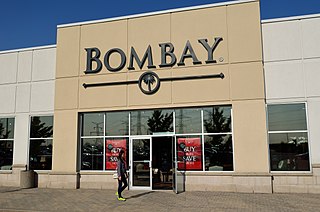Related Research Articles

Canadian Tire Corporation, Limited is a Canadian retail company which operates in the automotive, hardware, sports, leisure and housewares sectors. Its Canadian operations include: Canadian Tire, Mark's, FGL Sports, PartSource, and the Canadian operations of Party City. Canadian Tire acquired the Norwegian clothing and textile company Helly Hansen from the Ontario Teachers' Pension Plan in 2018.

The F. W. Woolworth Company was a retail company and one of the pioneers of the five-and-dime store. It was among the most successful American and international five-and-dime businesses, setting trends and creating the modern retail model that stores follow worldwide today.

Nordstrom, Inc. is an American luxury department store chain headquartered in Seattle, Washington, and founded by John W. Nordstrom and Carl F. Wallin in 1901. The original Wallin & Nordstrom store operated exclusively as a shoe store, and a second Nordstrom's shoe store opened in 1923. The growing Nordstrom Best chain began selling clothing in 1963, and became the Nordstrom full-line retailer that presently exists by 1971. The company founded its off-price Nordstrom Rack division in 1973, and grew both full-line and off-price divisions throughout the United States in the following years. The full-line division competes with department stores including Bloomingdale's, Macy's, Neiman Marcus, and Saks Fifth Avenue, while the off-price division competes with retailers including the TJX Companies and Ross Stores. Previous expansions beyond the contiguous United States include Puerto Rico (2015–2020) and Canada (2014–2023).

Sears Canada Inc. was a publicly-traded Canadian company affiliated with the American-based Sears department store chain. In operation from 1952 until January 14, 2018, and headquartered in Toronto, Ontario, the company began as Simpsons-Sears—a joint venture between the Canadian Simpsons department store chain and the American Sears chain—which operated a national mail order business and co-branded Simpsons-Sears stores modelled after those of Sears in the U.S. After the Hudson's Bay Company purchased Simpsons in 1978, the joint venture was dismantled and Hudson's Bay sold its shares in the joint venture to Sears; with Sears now fully owning the company, it was renamed Sears Canada Inc. in 1984. In 1999, Sears Canada acquired the remaining assets and locations of the historic Canadian chain Eaton's. From 2014, Sears Holdings owned a 10% share in the company. ESL Investments was the largest shareholder of Sears Canada.

The Robert Simpson Company Limited, commonly known as Simpson's until 1972, then as Simpsons, and in Quebec sometimes as Simpson, was a Canadian department store chain that had its earliest roots in a store opened in 1858 by Robert Simpson.

The T. Eaton Company Limited, later known as Eaton's and then Eaton, was a Canadian department store chain that was once the largest in the country. It was founded in 1869 in Toronto by Timothy Eaton, an immigrant from what is now Northern Ireland. Eaton's grew to become a retail and social institution in Canada, with stores across the country, buying-offices around the globe, and a mail-order catalog that was found in the homes of most Canadians. A changing economic and retail environment in the late twentieth century, along with mismanagement, culminated in the chain's bankruptcy in 1999.

Reader's Digest is an American general-interest family magazine, published ten times a year. Formerly based in Chappaqua, New York, it is now headquartered in midtown Manhattan. The magazine was founded in 1922 by DeWitt Wallace and his wife Lila Bell Wallace. For many years, Reader's Digest was the best-selling consumer magazine in the United States; it lost that distinction in 2009 to Better Homes and Gardens. According to Media Mark Research (2006), Reader's Digest reached more readers with household incomes of over $100,000 than Fortune, The Wall Street Journal, Business Week, and Inc. combined.
A discount store or discounter offers a retail format in which products are sold at prices that are in principle lower than an actual or supposed "full retail price". Discounters rely on bulk purchasing and efficient distribution to keep down costs.

Now, also known as NOW Magazine is an online publication based in Toronto, Ontario, Canada. Through most of its existence, Now was a free alternative weekly newspaper. Physical publication of Now was suspended in August 2022, amid the bankruptcy of its former owner Media Central Corporation, although some new content was still published to its website.

Holt, Renfrew & Co., Limited is a Canadian luxury department store chain founded in 1837 by William S. Henderson. The original William Ashton & Co. store in Quebec City, Lower Canada operated as a fur shop. The company serviced the greater North American and European markets with its mail order catalog beginning in the late 1800s, and was appointed Furriers in Ordinary to several members of the British royal family from 1886 to 1921.

Frederick & Nelson was a department store chain in the northwestern United States, based in Seattle, Washington. Founded in 1891 as a furniture store, it later expanded to sell other types of merchandise. The company was acquired by Marshall Field & Company in 1929. By 1980, the Frederick & Nelson chain had expanded to 10 stores in two states. The company went out of business in 1992. Its former Seattle flagship store building is now occupied by the flagship Nordstrom store.
Maclean-Hunter (M-H) was a Canadian communications company, which had diversified holdings in radio, television, magazines, newspapers and cable television distribution.

The Bombay Company is an American furniture and home accessories retailer owned by an undisclosed LLC. At one time a chain of over 500 stores headquartered in Fort Worth, Texas, Bombay Company was relaunched in 2012 as an online store. After its owners arranged a new licensing deal, a second online re-launch was planned for the High Point Market in April 2018. However, by March 2019, the online sales function of their website was still not active.
The architecture of Canada is, with the exception of that of Canadian First Nations, closely linked to the techniques and styles developed in Canada, Europe and the United States. However, design has long needed to be adapted to Canada's climate and geography, and at times has also reflected the uniqueness of Canadian culture.

The Merchandise Building is a loft conversion of a former warehouse located in downtown Toronto on Dalhousie Street, near the campus of Toronto Metropolitan University and the Toronto Eaton Centre. Built in various stages from 1910 to 1949 for the Simpson's department store, and later owned by Sears Canada after Simpson's demise, the Merchandise Building at over 1,000,000 square feet (93,000 m2) is one of the largest buildings by floor area in downtown Toronto. It is an example of the early 20th-century industrial Chicago School architectural style.

Henri Bendel, Inc., established in 1895, was a women's department store based in New York City which in its later history sold women's handbags, jewelry, luxury fashion accessories, home fragrances, chocolate and gifts. Its New York City store was located at 10 West 57th street. In 1985, when purchased by Limited, the new owner moved the store to 712 Fifth Avenue.

White House Black Market is an American women's clothing retailer headquartered in Fort Myers, Florida. The multichannel brand, founded in 1985, specializes in upscale clothing.
Retail design is a creative and commercial discipline that combines several different areas of expertise together in the design and construction of retail space. Retail design is primarily a specialized practice of architecture and interior design; however, it also incorporates elements of industrial design, graphic design, ergonomics, and advertising.

The architecture of Toronto is an eclectic combination of architectural styles, ranging from 19th century Georgian architecture to 21st century postmodern architecture and beyond.

Canadian Homes and Gardens was a magazine published by Maclean-Hunter in Canada from 1925 until 1962, succeeded by Canadian Homes, which was published until 1978. It targeted an upper middle class or upper class market, mainly of women, giving advice on home decoration. The distinction between editorial content and advertising was blurred.
References
- ↑ "The Press: Enter House & Home". Time. New York.
- ↑ "U.S. Modernist, Architecture You Love". U.S. Modernist. Durham, North Carolina.
- ↑ "Lynda Reeves". House & Home. Toronto, Ontario, Canada.